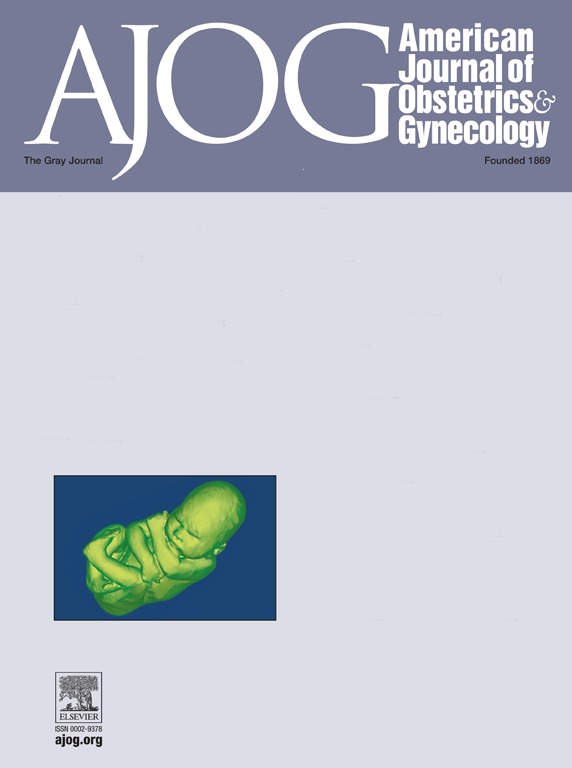Blood pressure control in pregnant patients with chronic hypertension and diabetes: should <130/80 be the target?
IF 8.4
1区 医学
Q1 OBSTETRICS & GYNECOLOGY
引用次数: 0
Abstract
Background
The Chronic Hypertension and Pregnancy Study demonstrated that a target blood pressure of <140/90 mm Hg during pregnancy is associated with improved perinatal outcomes. Outside of pregnancy, pharmacologic therapy for patients with diabetes and hypertension is adjusted to a target blood pressure of <130/80 mm Hg. During pregnancy, patients with both diabetes and chronic hypertension may also benefit from tighter control with a target blood pressure <130/80 mm Hg.
Objective
We compared perinatal outcomes in patients with hypertension and diabetes who achieved blood pressure <130/80 vs 130 to 139/80 to 89 mm Hg.
Study Design
This was a secondary analysis of a multcenter randomized controlled trial. Participants were included in this secondary analysis if they had diabetes diagnosed prior to pregnancy or at <20 weeks of gestation and at least 2 recorded blood pressure measurements prior to delivery. Average systolic and diastolic blood pressure were calculated using ambulatory antenatal blood pressures. The primary composite outcome was preeclampsia with severe features, indicated preterm birth <35 weeks, or placental abruption. Secondary outcomes were components of the primary outcome, cesarean delivery, fetal or neonatal death, neonatal intensive care unit admission, and small for gestational age. Comparisons were made between those with an average systolic blood pressure <130 mm Hg and average diastolic blood pressure <80 mm Hg and those with an average systolic blood pressure 130 to 139 mm Hg or diastolic blood pressure 80 to 89 mm Hg using Student’s t test and chi-squared tests. Multivariable log-binomial regression models were used to evaluate risk ratios between blood pressure groups for dichotomous outcomes while accounting for baseline covariates.
Results
Of 434 participants included, 150 (34.6%) had an average blood pressure less than 130/80 mm Hg. Participants with an average blood pressure less than 130/80 were more likely to be on antihypertensive medications at the start of pregnancy and more likely to have newly diagnosed diabetes mellitus prior to 20 weeks. Participants with an average blood pressure less than 130/80 mm Hg were less likely to have the primary adverse perinatal outcome (19.3% vs 46.5%, adjusted relative risk 0.43, 95% confidence interval 0.30–0.61, P<.01), with decreased risks specifically of preeclampsia with severe features (adjusted relative risk 0.35, 95% confidence interval 0.23–0.54) and indicated preterm birth prior to 35 weeks (adjusted relative risk 0.44, 95% confidence interval 0.24–0.79). The risk of neonatal intensive care unit admission was lower in the lower blood pressure group (adjusted relative risk 0.74, 95% confidence interval 0.59–0.94). No differences were noted in cesarean delivery (adjusted relative risk 1.04, 95% confidence interval 0.90–1.20), fetal or neonatal death (adjusted relative risk 0.59, 95% confidence interval 0.12–2.92). Small for gestational age less than the 10th percentile was lower in the lower blood pressure group (adjusted relative risk 0.37, 95% confidence interval 0.14–0.96).
Conclusion
In those with chronic hypertension and diabetes prior to 20 weeks, achieving an average goal blood pressure of <130/80 mm Hg may be associated with improved perinatal outcomes.
慢性高血压和糖尿病妊娠患者的血压控制:目标血压应低于 130/80?
背景慢性高血压与妊娠研究(CHAP)表明,妊娠期目标血压小于 140/90 mm Hg 与围产期预后的改善有关。在妊娠期外,糖尿病和高血压患者的药物治疗目标血压应调整为小于 130/80 mm Hg。在怀孕期间,糖尿病和慢性高血压患者也可以从目标血压(BP)<130/80 mm Hg 的严格控制中获益。目的我们比较了血压<130/80 mm Hg 与 130-139/80-89 mm Hg 的高血压和糖尿病患者的围产期预后。如果参与者在妊娠前或妊娠小于 20 周时被诊断出患有糖尿病,并且在分娩前至少有两次血压测量记录,则被纳入本次二次分析。平均收缩压和舒张压是通过产前动态血压计算得出的。主要综合结果是具有严重特征的子痫前期、妊娠<35周的早产或胎盘早剥。次要结果包括主要结果的组成部分、剖宫产、胎儿或新生儿死亡、入住新生儿重症监护室(NICU)和胎龄小(SGA)。采用学生 t 检验和卡方检验对平均收缩压小于 130 mm Hg 和平均舒张压小于 80 mm Hg 的产妇与平均收缩压 130-139 mm Hg 或舒张压 80-89 mm Hg 的产妇进行比较。在考虑基线协变量的情况下,采用多变量对数二叉回归模型评估血压组间二分法结果的风险比。结果 在纳入的 434 名参与者中,150 人(34.6%)的平均血压低于 130/80 mm Hg。平均血压低于 130/80 的参与者更有可能在怀孕初期服用降压药,也更有可能在怀孕 20 周前新诊断出糖尿病。平均血压低于 130/80 mm Hg 的受试者发生围产期主要不良结局的几率较低(19.3% vs 46.5%,调整后相对风险 (aRR) 0.43,95% CI 0.30-0.61,p<0.01),尤其是发生重度子痫前期(aRR 0.35,95% CI 0.23-0.54)和 35 周前早产(aRR 0.44,95% CI 0.24-0.79)的风险较低。低血压组的新生儿重症监护室入院风险较低(aRR 0.74,95% CI 0.59-0.94)。在剖宫产(aRR 1.04,95% CI 0.90-1.20)、胎儿或新生儿死亡(aRR 0.59,95% CI 0.12-2.92)方面无差异。结论 对于那些在 20 周前患有慢性高血压和糖尿病的孕妇,平均目标血压小于 130/80 mm Hg 可能与围产期预后的改善有关。
本文章由计算机程序翻译,如有差异,请以英文原文为准。
求助全文
约1分钟内获得全文
求助全文
来源期刊
CiteScore
15.90
自引率
7.10%
发文量
2237
审稿时长
47 days
期刊介绍:
The American Journal of Obstetrics and Gynecology, known as "The Gray Journal," covers the entire spectrum of Obstetrics and Gynecology. It aims to publish original research (clinical and translational), reviews, opinions, video clips, podcasts, and interviews that contribute to understanding health and disease and have the potential to impact the practice of women's healthcare.
Focus Areas:
Diagnosis, Treatment, Prediction, and Prevention: The journal focuses on research related to the diagnosis, treatment, prediction, and prevention of obstetrical and gynecological disorders.
Biology of Reproduction: AJOG publishes work on the biology of reproduction, including studies on reproductive physiology and mechanisms of obstetrical and gynecological diseases.
Content Types:
Original Research: Clinical and translational research articles.
Reviews: Comprehensive reviews providing insights into various aspects of obstetrics and gynecology.
Opinions: Perspectives and opinions on important topics in the field.
Multimedia Content: Video clips, podcasts, and interviews.
Peer Review Process:
All submissions undergo a rigorous peer review process to ensure quality and relevance to the field of obstetrics and gynecology.

 求助内容:
求助内容: 应助结果提醒方式:
应助结果提醒方式:


